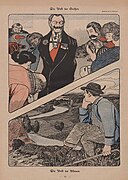Simplicissimus (magazine)
You can help expand this article with text translated from the corresponding article in German. (May 2022) Click [show] for important translation instructions.
|
This article needs additional citations for verification. (January 2011) |
- Simplicissimus is also a name for the 1668 novel Simplicius Simplicissimusand its protagonist.
Simplicissimus (German:
Combining brash and politically daring content with a bright, immediate, and surprisingly modern graphic style, Simplicissimus published the work of writers such as
Robert Walser, Heinrich Zille, Hugo von Hofmannsthal, Heinrich Mann, Lessie Sachs, and Erich Kästner
.
Although the magazine's satirical nature was largely indulged by the German government, an 1898 cover mocking
gold marks. A six-month prison sentence was given to the cartoonist Thomas Theodor Heine and seven months to the writer Frank Wedekind. All the defendants were charged with "insulting a royal majesty."[4] Again, in 1906, the editor Ludwig Thoma was imprisoned for six months for attacking the clergy. These controversies only served to increase circulation, which peaked at about 85,000 copies. Upon Germany's entry into World War I, the weekly dulled its satirical tone, began supporting the war effort, and considered closing down. Thereafter, the strongest political satire expressed in graphics became the province of artists George Grosz and Käthe Kollwitz (who were both contributors) and John Heartfield
.
Hitler Look Like? by cartoonist Thomas Theodor Heine
. A satirical gallery from the 28 May 1923 105-116 issue of Simplicissimus magazine early in Hitler's Munich political career, when there were no publicly available photographsThe editor Ludwig Thoma joined the army in a medical unit in 1917, and lost his taste for satire, denouncing his previous work at the magazine, calling it immature and deplorable.
During the
Edward Thöny, Erich Schilling, and Wilhelm Schulz, remained and toed the Nazi party line, for which they were rewarded by the Nazis.[6] The magazine adopted an aggressive satirical approach towards the Jews during this period, in line with the Nazi magazine Die Brennessel.[7]
Simplicissimus continued publishing, in declining form, until finally ceasing publication in 1944. It was revived from 1954–1967.
Other graphic artists associated with the magazine included
Ferdinand von Reznicek, Joseph Sattler, and Jeanne Mammen
.
Gallery
- A selection of Simplicissimus art
-
Illustration from 1896.
-
Cover from 1896. Art by Thomas Theodor Heine.
-
Cartoon from 1898. Art by Hans Rossmann.
-
Simplicissimus Künstler-Kneipe und Kathi Kobus. Herausgegeben vom Hausdichter Hans Bötticher, cover from 1909, with the magazine's iconic bulldog designed by Thomas Theodor Heine.
-
Cover from 1913. Art by Brynolf Wennerberg.
-
Illustration from 1917. Art by Otto Lendecke.
-
Cartoon from 1923. Art by Erich Schilling.
See also
- Bauhaus
- Gesamtkunstwerk
- List of magazines in Germany
- Jugend (magazine)
- Jugendstil
- Pan (magazine)
- Secession (art)
- Ulenspiegel
Notes
- ^ Harvard University Library Catalog, Hollis number 006013229.
- ^ "'Mussolini Triumphator', caricature from 'Simplicissimus' magazine". Bridgeman Images. Retrieved 21 February 2016.
- ISBN 978-0-231-53136-8. Retrieved 23 February 2016.
- ^ ""Simplicissimus" and the Palestine issue: Satire's timeless appeal - Qantara.de". Qantara.de - Dialogue with the Islamic World. Retrieved 2018-11-02. With the abdication of the German emperor and the German princes following World War I, the law became invalid (the paragraph incorrectly referred to in the article did not penalize the insult of the German head of state, but the defamation of organs and representatives of foreign states; it was abolished in 2017).
- ^ "Simplicissimus · die historische Satirezeitschrift · Blättern".
- ^ Klaus Mann: Der Simplicissimus. In: Das Neue Tagebuch, V. Jahrgang 1937, p. 214 (in German)
- JSTOR 43917315.
External links
Wikimedia Commons has media related to Simplicissimus.
- Simplicissimus.info: Digital archive of back issues from 1896–1944 (in German)
- An academic appreciation of several of its notable illustrators
- What Does Hitler Look Like? A satirical gallery from the 5-28-23 105-116 issue, early in Hitler's political career, when there were no publicly available photographs











